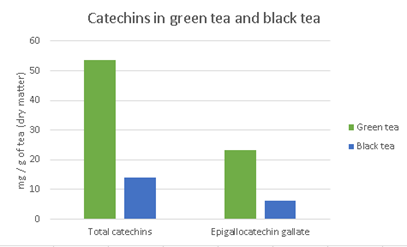Catechins in Tea

This post is also available in:
This post is also available in:
![]() Español (Spanish)
Español (Spanish) ![]() Français (French)
Français (French) ![]() हिन्दी (Hindi)
हिन्दी (Hindi) ![]() Ελληνικά (Greek)
Ελληνικά (Greek) ![]() Português (Portuguese (Brazil))
Português (Portuguese (Brazil))
Lately, beneficial compounds for health have been known to be found in unusual foods produced in remote places. This is not the case with catechins, highly healthful compounds abundant in a widely known and globally disseminated beverage: tea.
Tea originated in China, where it has been consumed for over 5,000 years. During the 10th century, its consumption spread outside China, becoming popular in Japan, Nepal and Tibet. In the 17th century, Dutch explorers brought it to Europe, where it was well accepted in Portugal, England, France and Germany. Due to its beneficial health properties, tea was sold as a medicine rather than as food. Due to its success, Dutch traders took it to New Amsterdam, now New York, where it also became appreciated by North American consumers. Later on, its diffusion in Latin America was not smooth, since many countries already had consolidated local beverages, such as coffee and yerba mate. Despite this, tea managed to gain a place in Latin America. Nowadays, after water, tea is the most consumed beverage worldwide.
All tea-consuming civilizations recognized it as a healthy drink. For this reason, it has been studied extensively. Tea is rich in polyphenols, a varied group of compounds with high antioxidant capacity. Here we will delve into a subgroup of them: the catechins, abundant in tea and of high interest for human health.
It is known that there are many types of tea. The best-known are green and black tea. Both come from the same species: Camellia sinensis. Green tea is made of intact leaves, so its catechins are not diminished. To make black tea, the leaves are crushed, which promotes the oxidation of catechins, thus their degradation, forming dark compounds. So, green tea and black tea come from the same plant, with black tea resulting from the oxidation of green tea catechins. Therefore, black tea is lower in catechins compared to green tea (Figure 1). A similar case is seen in apples based on the same principle. If this fruit receives a punch, the polyphenol oxidase enzyme inside it is released, which leads to the oxidation of its phenolic compounds, forming new dark compounds. This shows that nature works with similar patterns for apparently different foods!

Figure 1. Total catechins and epigallocatechin gallate (the most abundant catechin) in green and black tea. (Adapted from Khokar and Magnusdottir, 2002).
Catechins give green tea many of its beneficial properties, which, as they are present in more significant amounts than in black tea, make green tea a healthier beverage. Catechins are among nature’s most potent antioxidants. They have the highest bioactivity in green tea, with proven in vitro and in vivo effects. Catechins trap different free radicals in the body. Thus they prevent undesirable oxidation reactions from occurring. They can also trap toxic metals within the body, which, if free, will catalyze harmful oxidative reactions. They are such good antioxidants that are often added to various foods as a natural antioxidant. Catechins are present in several foods, green tea being one of the best sources: 30% of the weight of the leaf, when dry, is made up of catechins. To a lesser extent, they are also present in cocoa, broad beans, apples and black grapes.
Catechins can reduce weight and body fat. This is explained by the fact that catechins act on the sympathetic nervous system, contributing to an increment of the energy needed to perform a particular activity, thus positively altering the body’s energy expenditure. This mechanism is still under investigation because studies that reached this conclusion are mostly animal-based. Studies in humans are not that conclusive. Nonetheless, having positive results in animals gives a good indication. On the other hand, there is an interesting outcome from the human studies: comparing the same doses of green tea consumed, Asian people showed a higher decrease in weight and body fat compared to Caucasian people, so race also might influence the effect of catechins.
The effects of weight and body fat reduction are potentiated by caffeine consumption. As green tea contains considerable amounts of caffeine (a cup of green tea has 75 mg of catechins and 35 mg of caffeine, on average), this commodity provides a potentiated effect of weight and body fat reduction compared to others that contain just catechins. Of course, this does not mean we should drink green tea excessively since we do not want to stay awake because of its caffeine.
Also, catechins inhibit two critical enzymes for carbohydrate digestion: α-amylase and α-amyloglucosidase, leading ingested carbohydrates to absorb less sugar, contributing to body weight regulation. This effect is shown in vitro and animal and human studies. In addition, catechins affect fat metabolism, another mechanism for body weight and body fat decrease. In animal studies, catechins are reported to stimulate lipolysis of peripheral adipose tissues. However, human studies are not that conclusive. So, the research is still in progress.
In addition, catechins have other beneficial effects. It is reported in animal studies that catechins can prevent malignant tumours in the skin, lungs, oesophagus, stomach, liver, colon and prostate. Due to the ability of catechins to bind proteins that, if free in the body, will promote excessive cell growth, which is a prerequisite for the development of tumours.
As catechins are mainly consumed in green tea, it is essential to know how to prepare it and extract as much as possible from its leaves. Catechins are best extracted in acidic and neutral media, so making our tea cup with pure or slightly acidified water (for example, with some lemon juice) is a good option. Catechins are destroyed in alkaline media. Therefore, a higher concentration is obtained when infused in pure water, contrary to if infused in water with a high concentration of salts. As for the temperature, the hotter the water, the more catechins will be extracted, reaching a peak of extraction at 80 °C. At higher temperatures, undesired compounds will be formed. The extraction of catechins depends on the temperature of the water used, and there is no point in increasing the temperature above 80 °C (Figure 2).

Figure 2. Effect of the water temperature in the catechins extraction. (Voung et al., 2011)
For all these reasons, a toast with green tea never hurts!
References:
- Ananingsih, V.; Sharma, A.; Zhou, W. (2013). Green tea catechins during food processing and storage: A review on stability and detection. Food Research International, 50(2), 469–479. doi:10.1016/j.foodres.2011.03.004
- Botten, D.; Fugallo, G.; Fraternali, F.; Molteni, C. (2015). Structural Properties of Green Tea Catechins. The Journal of Physical Chemistry B, (), 150914222808001–. doi:10.1021/acs.jpcb.5b08737
- Gadkari, P.; Balaraman, M. (2015). Catechins: Sources, extraction and encapsulation: A review. Food and Bioproducts Processing, 93(), 122–138. doi:10.1016/j.fbp.2013.12.004
- Khokhar, S., Magnusdottir, S., 2002. Total phenol, catechin, andcaffeine contents of teas commonly consumed in the UnitedKingdom. J. Agric. Food Chem. 50, 565–570
- Rains, T.; Agarwal, S.; Maki, K. (2011). Antiobesity effects of green tea catechins: a mechanistic review. , 22(1), 1–7. doi:10.1016/j.jnutbio.2010.06.006
- Vuong, Q.; Golding, J.; Stathopoulos, C.; Nguyen, M.; Roach, P. (2011). Optimizing conditions for the extraction of catechins from green tea using hot water. , 34(21), 3099–3106. doi:10.1002/jssc.201000863
- https://www.teainstitute.cl/2020/05/12/historia-del-te-como-nacio-el-consumo-de-te-en-europa-y-america/








































































